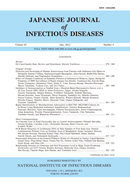71 巻, 1 号
選択された号の論文の18件中1~18を表示しています
- |<
- <
- 1
- >
- >|
Original Article
-
2018 年 71 巻 1 号 p. 1-7
発行日: 2018年
公開日: 2018/01/23
[早期公開] 公開日: 2017/10/31PDF形式でダウンロード (3923K) -
2018 年 71 巻 1 号 p. 8-13
発行日: 2018年
公開日: 2018/01/23
[早期公開] 公開日: 2017/10/31PDF形式でダウンロード (116K) -
2018 年 71 巻 1 号 p. 14-20
発行日: 2018年
公開日: 2018/01/23
[早期公開] 公開日: 2017/10/31PDF形式でダウンロード (177K) -
2018 年 71 巻 1 号 p. 21-27
発行日: 2018年
公開日: 2018/01/23
[早期公開] 公開日: 2017/10/31PDF形式でダウンロード (349K) -
2018 年 71 巻 1 号 p. 28-32
発行日: 2018年
公開日: 2018/01/23
[早期公開] 公開日: 2017/12/26PDF形式でダウンロード (1632K) -
2018 年 71 巻 1 号 p. 33-38
発行日: 2018年
公開日: 2018/01/23
[早期公開] 公開日: 2017/12/26PDF形式でダウンロード (711K) -
2018 年 71 巻 1 号 p. 39-44
発行日: 2018年
公開日: 2018/01/23
[早期公開] 公開日: 2017/12/26PDF形式でダウンロード (872K) -
2018 年 71 巻 1 号 p. 45-50
発行日: 2018年
公開日: 2018/01/23
[早期公開] 公開日: 2017/12/26PDF形式でダウンロード (806K) -
2018 年 71 巻 1 号 p. 51-57
発行日: 2018年
公開日: 2018/01/23
[早期公開] 公開日: 2017/12/26PDF形式でダウンロード (186K)
Short Communication
-
2018 年 71 巻 1 号 p. 58-61
発行日: 2018年
公開日: 2018/01/23
[早期公開] 公開日: 2017/10/31PDF形式でダウンロード (451K) -
2018 年 71 巻 1 号 p. 62-64
発行日: 2018年
公開日: 2018/01/23
[早期公開] 公開日: 2017/10/31PDF形式でダウンロード (147K) -
2018 年 71 巻 1 号 p. 65-67
発行日: 2018年
公開日: 2018/01/23
[早期公開] 公開日: 2017/10/31PDF形式でダウンロード (202K) -
2018 年 71 巻 1 号 p. 68-71
発行日: 2018年
公開日: 2018/01/23
[早期公開] 公開日: 2017/12/26PDF形式でダウンロード (280K) -
Isolation and Complete Genome Sequencing of Zika Virus Imported from the Dominican Republic to Japan2018 年 71 巻 1 号 p. 72-74
発行日: 2018年
公開日: 2018/01/23
[早期公開] 公開日: 2017/12/26PDF形式でダウンロード (414K) -
2018 年 71 巻 1 号 p. 75-78
発行日: 2018年
公開日: 2018/01/23
[早期公開] 公開日: 2017/12/26PDF形式でダウンロード (189K)
Method
-
2018 年 71 巻 1 号 p. 79-84
発行日: 2018年
公開日: 2018/01/23
[早期公開] 公開日: 2017/10/31PDF形式でダウンロード (230K)
Laboratory and Epidemiology Communications
-
2018 年 71 巻 1 号 p. 85-87
発行日: 2018年
公開日: 2018/01/23
[早期公開] 公開日: 2017/10/31PDF形式でダウンロード (149K) -
2018 年 71 巻 1 号 p. 88-89
発行日: 2018年
公開日: 2018/01/23
[早期公開] 公開日: 2017/12/26PDF形式でダウンロード (402K)
- |<
- <
- 1
- >
- >|
